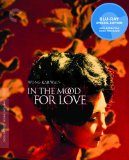| Reviews & Columns |
|
Reviews DVD TV on DVD Blu-ray 4K UHD International DVDs In Theaters Reviews by Studio Video Games Features Collector Series DVDs Easter Egg Database Interviews DVD Talk Radio Feature Articles Columns Anime Talk DVD Savant Horror DVDs The M.O.D. Squad Art House HD Talk Silent DVD
|
DVD Talk Forum |
|
|
| Resources |
|
DVD Price Search Customer Service #'s RCE Info Links |
|
Columns
|
|
|
In the Mood for Love: The Criterion Collection
THE MOVIE:
Please Note: The stills used here are taken from promotional materials and Criterion's original 2002 DVD included in the package and not the Blu-ray edition under review.
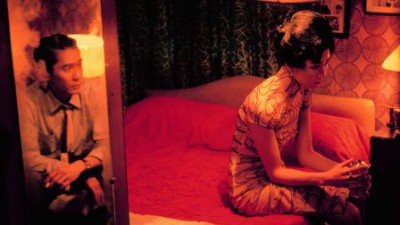
If I could go back in time and rejoin myself in a position just prior to having seen In the Mood for Love, I would do it in a heartbeat. Oh, to relive that first taste of love! To fall under the spell of Wong Kar-Wai's romantic tragedy as an innocent once more! Sure, In the Mood for Love gets deeper and more fulfilling the more often you watch it, but nothing will ever compare to that first blush of discovery, of experiencing its lush pleasures unaware.
In the Mood for Love takes place in Hong Kong in 1962. It begins as two couples, the Chows and the Chans, rent rooms in neighboring apartments. Tellingly, only one spouse from each couple is there to look at the rooms; their absent halves will be absent for most of the movie, and when they do appear, it's either just off screen or with their faces just out of frame. Mrs. Chan (played by Maggie Cheung Man-yuk, from Clean and Irma Vep) is renting a room from the elderly Mrs. Suen (Rebecca Pan), while Mr. Chow (Tony Leung Chiu-Wai, Infernal Affairs) takes the space next door with the Koos. The floor of their building is its own community. The older landlords regularly share meals and play mahjong late into the night.
For Mr. Chow and Mrs. Chan, however, this welcoming environment soon becomes a place of deep loneliness. Their partners are increasingly absent, both apparently called away to work overseas in Japan. The husband and wife that remain eat take-out noodles in their rooms, passing each other in the hallway going to and from the restaurant, on their way out and coming back home from work. They share pleasantries, and discuss a mutual affection for martial arts stories. The connection between them is tenuous at first, but as time passes, they begin to notice they are alone at the same times. Other telltale clues emerge, and before long, they realize that their missing spouses are having an affair.
It's fitting that once the truth is revealed, we never see Mrs. Chow or Mr. Chan again. Their presence is felt, but for all intents and purposes, they are gone and not coming back. The pair they left behind becomes friends, bonding over their shared heartache, and eventually falling in love themselves. Except, the true heartbreak of In the Mood for Love is that these jilted romantics are both too good for their respective spouses and too committed to their marriage vows to follow through on their own feelings. They don't want to stoop to being cheaters themselves. Instead, they spend their time role playing, trying to imagine how Mr. Chan might have seduced Mrs. Chow, and vice versa. They rent a hotel room, but it's to lock themselves away, dreaming up martial arts serials together, imagining a more noble and passionate life than the one they share in the real world.
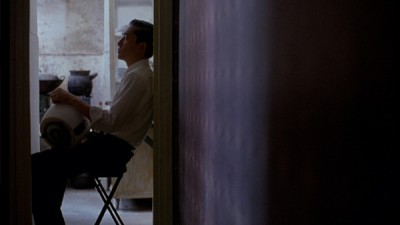
In the Mood for Love is the second part of a semi-official narrative trilogy that starts with Wong Kar-Wai's second feature Days of Being Wild and concludes with the more recent 2046, which picks up with Mr. Chow years later, alone, a successful writer, broken-hearted. The film perhaps best exemplifies the writer/director's improvisational style, notable for having begun life as a comedy about food before morphing into the sad tale of love's failure. In the Mood for Love has its own unmistakable rhythm, something comparable to the duplication and growth in Alain Resnais' adultery drama Last Year at Marienbad, but more self-contained and grounded. You'll be amazed by how many times two people can walk up and down the same stairwell and how it can have a different meaning every time. Pain and disappointment compounds and self-replicates even as love blossoms, the repetition creating echoes that deepen the emotions rather than dull them. Additionally, Mark Galasso's music cues enhance the drama by signaling the different sentimental beats, working the audience to a point where our response to the familiar melodic strains becomes almost Pavlovian. The orchestration is like a glacier slowly blanketing the film in icy sorrow.
The reason so many romantic comedies don't work is the same reason that an untraditional, experimental film like In the Mood for Love does. It's because most romantics, the true ones, are actually cynics. They want to believe in love, but experience has taught them to be distrustful; at the same time, they staunchly defend their romantic ideals. Sure, it would be lovely to see a version of In the Mood for Love where Mrs. Chan and Mr. Chow throw caution to the wind and succumb to their passions, but something would be lost as a result. Their love is purified by their pain. Ironically, they are more the married couple than the absent lovers. Their lives devolve into routine and familiarity. Perhaps the true secret of their maintaining their connection is that by denying their desires, those desires increase. As long as they are together, they have something more to look forward to.
In a better world, Tony Leung and Maggie Cheung would be the biggest stars on the planet. What they do here is remarkable. The emotional core of In the Mood for Love relies on what isn't said. The communication is all in gesture and expression. Even when the two are speaking, more often than not they are pretending to be someone else. Their games fall apart because they can't fake being what they are not, and there is more honesty in these acts of pretend than you'll find in most performances in mainstream love stories. There is a scene 2/3 into In the Mood for Love when Mrs. Chan breaks down. The pressure of the gossip about her relationship with Chow and the inevitability that she will lose him is too much for her to bear. The actors go to two different places here: she is given to great heaving sobs, he must stand stalwart and resolute. Both portrayals are devastating. The true agony of a relationship ending is evident in how they hold themselves, how they look away from one another. The hurt vibrates through every fiber of their being.
For all the resonance of In the Mood for Love's narrative, what makes it even more special is how beautiful it is to look at. This is the kind of film you could just as easily put on mute and let it run in the background. Directors of photography Mark Li Pin-Bin and Christopher Doyle (Hero) and art director Man Lim-Chung work with Wong Kar-Wai to create a nearly surreal, painterly version of early-'60s Hong Kong. The urban landscapes appear inspired by Edward Hopper, with their solid colors and idyllic lighting, turning the cramped spaces into almost otherworldly, futuristic visions. (Indeed, in 2046, when the story leaps from the real past to an imagined science-fiction future, it's not much of a leap at all.) Part of our willingness to stick with the movie's reverberating storytelling pattern is our willingness to keep staring at all the lovely detail, be it the red-hot décor of the hotel getaway or the hypnotic patterns of Maggie Cheung's amazing wardrobe. In much the same way we revisit our favorite songs (indeed, even on the soundtrack itself, which uses Nat "King" Cole as part of Galasso's score), we also revisit our favorite images, like flipping through a book of photos and paintings.
It's like I said at the outset, In the Mood for Love is a movie you will want to revisit again and again. Your understanding and appreciation of it will only increase, even as you yearn to be as innocent as you were when your path and it first intersected. Because if you could somehow get back there, if Mr. Chow and Mrs. Chan could always keep meeting for the first time, then they would never have to endure the anguish that will inevitably follow, and you might still believe that a better outcome is possible.
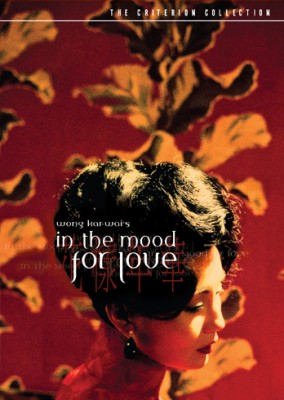
THE BLU-RAY
Video:
Director of photography Mark Lee Pin-bin oversaw the 1080p/AVC-MPEG 4 transfer, which comes to Blu-Ray as a gorgeous 1.66:1 widescreen image. This is a marvelous looking BD, the kind of disc that could easily be used to sell the format, as opposed to, say, all the CGI material that seems to run at my local electronics store to try to unload their widescreen TVs and Blu-Ray players. In the Mood for Love demonstrates the potential of high-definition in creating the look and feel of real life, while also maintaining the cinematic charms that enchanted us about Wong Kar-Wai's romantic drama in the first place.
Colors are vibrant, with a nicely rendered grain that maintains the look of the film stock while also adding to the period feel of the narrative. Skin tones look fabulous, and details run deep. For a film where the majority of the events are driven by facial expressions, this is a must. We want to be able to look into Maggie Cheung's eyes and see the emotion. The carefully articulated art direction is amazing to behold, from the paint on the walls of the slowly decaying apartments to the more lavish and lush decorations in the hotel. Likewise, our ability to see the weaving on all the fabric, be it curtains or Maggie's lovely, high-necked dresses, is just phenomenal. I could gush all day, scene by scene, detail by detail...Criterion has delivered exactly what I would have hoped for in a BD of In the Mood for Love.
Sound:
The 5.1 DTS-HD surround mix of the Cantonese soundtrack is simply dynamite. There are a lot of wonderful between-speaker effects, creating an immersive atmosphere via carefully chosen background details. Music sounds fantastic, and even better, the audio team has smartly positioned the music so that it doesn't steamroll over other sound effects. In particular, listen to the scene where the characters are caught in a rainstorm. The orchestration is placed in the front speakers while the sound of the rain is kicked to the back, creating an incredible aural landscape.
English subtitles are well written and evenly paced.
Extras:
For the Blu-Ray release of In the Mood for Love, Criterion has compressed its 2-disc DVD set onto one disc. It comes in a smaller case, but with the same 48-page booklet containing a critical assessment of the film and the original short story that inspired the movie.
As far as on-disc extras go, there has not been a straight transfer of bonus features one to the other. Most of the extras are still included, but a couple have been dropped and replaced with comparable supplements. Gone from the 2002 disc are the photo galleries of promotional and concept materials and crew biographies, as well as the interactive essay on the soundtrack and Gina Marchetti's examination of the film's setting. Replacing these are new interviews with critic Tony Rayns, including one that is specifically about the soundtrack and includes samples of the music cues. The second talks more in general about the film overall. The thing I am most sad to see gone is the extended biography of Kar-Wai, complete with gallery images and even trailers from his other films. I remember wishing back then that we'd someday get a DVD of Ashes of Time that looked remotely as good as the trailer.
Carried over from the previous DVD edition are Wong Kar-Wai's interview and "cinema lesson" from the movie's 2001 Cannes appearance, as well as the 2000 press conference from the Toronto International Film Festival, featuring the film's two stars. We also get Wong Kar-Wai's own documentary about the production, @ "In the Mood for Love," which explores the process by which the movie came together. Alongside this are the deleted scenes with director commentary.
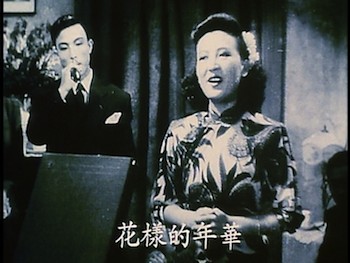
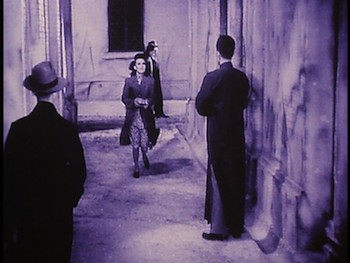
The (very) short film Hua yang de nian bua is Kar-Wai's musical tribute to Hong Kong actresses of yesteryear, compiling quick clips from old nitrate prints. The outfits and the shot compositions show a definite influence on his own style.
Finally, there are the film trailers and TV spots. There is one of each from Hong Kong, America, and France.
FINAL THOUGHTS:
If you read this far, you'll see that In the Mood for Love is one of my all-time favorite movies, and I couldn't be more thrilled by how it looks now that it's on Blu-Ray. Criterion has done a stellar job of updating their already incredible 2002 DVD to give movie fans a real reason to double-dip and upgrade. Wong Kar-Wai's turn of the century love story is one that doles out heartbreak in measures. The restraint that the story portrays, and how that is brought to life by stars Maggie Cheung and Tony Leung, is unmatched in terms of raw honesty; at the same time, In the Mood for Love is one of the most stylish movies you're ever likely to see. I don't know how many times I've seen this one now, but it just keeps getting better. DVD Talk Collector Series.
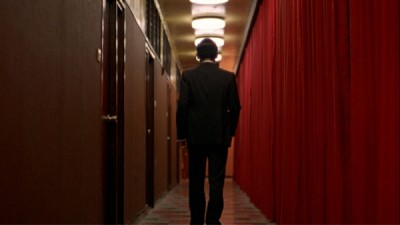
Jamie S. Rich is a novelist and comic book writer. He is best known for his collaborations with Joelle Jones, including the hardboiled crime comic book You Have Killed Me, the challenging romance 12 Reasons Why I Love Her, and the 2007 prose novel Have You Seen the Horizon Lately?, for which Jones did the cover. All three were published by Oni Press. His most recent projects include the futuristic romance A Boy and a Girl with Natalie Nourigat; Archer Coe and the Thousand Natural Shocks, a loopy crime tale drawn by Dan Christensen; and the horror miniseries Madame Frankenstein, a collaboration with Megan Levens. Follow Rich's blog at Confessions123.com.
|
| Popular Reviews |
| Sponsored Links |
|
|
| Sponsored Links |
|
|
| Release List | Reviews | Shop | Newsletter | Forum | DVD Giveaways | Blu-Ray | Advertise |
|
Copyright 2024 DVDTalk.com All Rights Reserved. Legal Info, Privacy Policy, Terms of Use,
Manage Preferences,
Your Privacy Choices | |||||||









